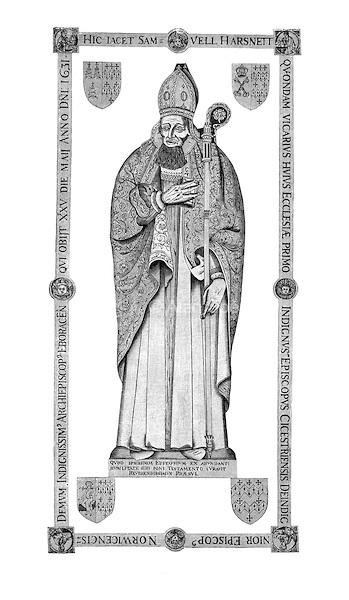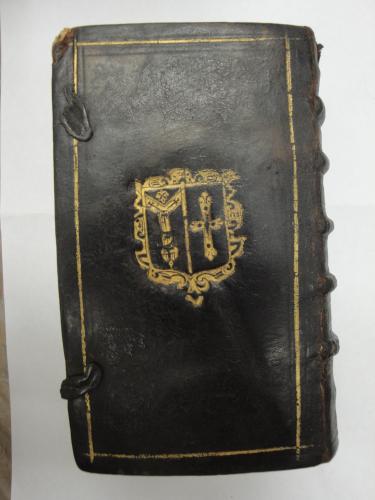Samuel Harsnett and his library
The collection that is the focus for this pilot project is a treasure trove and not just because of the fragments discussed here.
Just over 800 books are designated ‘Harsnett’ and now housed in the Special Collections of the Library of the University of Essex. It is, in very large part, the library of Samuel Harsnett, the son of a Colchester baker, born 1561, a Cambridge student who became Master of his old college, Pembroke (1605-1616), bishop successively of Chichester (1609-17) and of Norwich (1617-29), ending his career as Archbishop of York. He bequeathed his collection to his hometown, for the use of the local clergy. Some additions were made to the collection in the first couple of decades after Harsnett’s death in 1631. For much of their subsequent history, the books were kept in the Castle at the centre of the town; they were moved in the twentieth century into the Public Library and, more recently, were transferred to the University for their safe-keeping.
In terms of the works in the collection, the emphasis is on the theological, ranging across the learned languages as well as English. Harsnett considered it no shame to own works by his opponents across the confessional divide; he had traditional Catholic texts and controversialist works by the likes of Johann Eck, John Fisher, Stephen Gardiner and Robert Parsons. These are outnumbered, however, by the writings of reformers – not Luther himself, and relatively little Calvin, with Heinrich Bullinger and Peter Martyr Vermigli being more substantial presences, supplemented by local writers like John Jewel. In addition to this strength, there is a range of philosophical and historical works, classical and more recent. What does not appear in this collection are Harsnett’s own writings and some have expressed disappointment that the books given little explicit sign of his intellectual formation – there are, for instance, works on witchcraft but no annotations to show how they influenced the development of his own thinking. This frustration, though, is outweighed by the other elements of interest of his books.
The collection is particularly fortunate in retaining so many early bindings – and it is because of their presence that there is a goodly number of fragments in situ. The majority of the bindings are English, several from London, a few Oxford and a larger proportion from Cambridge. They have not been studied systematically as a collection and the entries in this database for Host Volumes should suggest how they could repay attention in their own right.
Equally significant is the provenance evidence furnished by many of the volumes in the collection. Harsnett, like most of his contemporaries, came by many of his books second-hand; that is why his library includes a score of incunables, as well as many volumes bound before his birth. Moreover, particular lines of descent to him can be detected: several of his books were previously owned by a colleague at Pembroke, Cambridge, John Field; others show signs of having been the possession of Sir Christopher Hatton (1540-1591), of Robert Dudley, earl of Leicester (1532/3-1588), and John, Lord Lumley (d. 1609). Perhaps most interesting are those which had been in other archbishops’ hands before Harsnett, all of them being the metropolitan of Canterbury: Thomas Cranmer, Matthew Parker (as discussed on this website), John Whitgift and Richard Bancroft. The fact, in particular, that Harsnett came to have volumes owned by the last two has caused some consternation: Archbishop Bancroft’s regulations for his library, incorporating that of his predecessor, were severe of their denunciation of anyone who removed books. It would appear that Harsnett, who owed some of his preferment to Bancroft and who was appointed his executor, considered his proximity allowed him to ignore those injunctions.
To learn more about Samuel Harsnett’s library, the most recent guide is the report produced by Francesca Galligan, on which the foregoing paragraphs are based.

